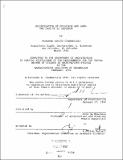| dc.contributor.advisor | John de Monchaux. | en_US |
| dc.contributor.author | Chamberlain, Fernando Adolfo | en_US |
| dc.coverage.spatial | nces--- | en_US |
| dc.date.accessioned | 2011-08-01T14:30:33Z | |
| dc.date.available | 2011-08-01T14:30:33Z | |
| dc.date.copyright | 1992 | en_US |
| dc.date.issued | 1992 | en_US |
| dc.identifier.uri | http://hdl.handle.net/1721.1/65029 | |
| dc.description | Thesis (M.S.)--Massachusetts Institute of Technology, Dept. of Architecture, 1992. | en_US |
| dc.description | Includes bibliographical references (leaves 111-115). | en_US |
| dc.description.abstract | Privatization lS a concern, in the world transition to market economies and management of real property portfolios (RPP) --- t.he building and land stock of a government. For political and technical reasons the Government of El Salvador's (GOES) process of privatization is unlikely to occur in the near future, in ways that could recognize either the real asset value or the highest and best use of the real property held by public institutions/State Owned Enterprises (SOE's). Literature on privatization of SOEs considers real property in only an incidental manner. No references were found regarding changes of use in real property held by State Owned Enterprises (SOE's). However, changes in real property uses , such as leaseholds , that have not been labeled as "privatization" have occurred for years in the public sector. A proposed privatization with a real asset management perspective includes: consideration of the opportunity cost of holding real property; distortions such as free - space subsidies; exchange- value and use-value tradeoff; and complementarity among properties. The GOES privatization initiatives include: a) the elimination of fiscal drain functions; b) the divestment of real assets to generate revenues for the budget; and c) the provision of land to squatters. The case studies show that, the current GOES privatization process does not account for the opportunity cost of holding SOEs whose space has the following characteristics: a) underutilized subsidized, and/or surplus to the GOES's needs; b) non- intensive- uses in prime development areas; c) potential for a highest and best use other than t he current use and/or d) characteristics that enhance other candidates real asset value . The GOES privatization program decision-making process responds to political pressures rather than technical arguments. The three different initiatives of the program lack overall vision and coordination. The GOES privatization takes place in a context of widespread mismanagement of the public sector' s RPP. This document proposes: a) to complement the current privatization evaluation with a real property asset management perspective; b ) to centralize the decision-making process of the different privatization initiatives; and c) the improvement of the current inventory efforts. | en_US |
| dc.description.statementofresponsibility | by Fernando Adolfo Chamberlain. | en_US |
| dc.format.extent | iv, 116 leaves | en_US |
| dc.language.iso | eng | en_US |
| dc.publisher | Massachusetts Institute of Technology | en_US |
| dc.rights | M.I.T. theses are protected by
copyright. They may be viewed from this source for any purpose, but
reproduction or distribution in any format is prohibited without written
permission. See provided URL for inquiries about permission. | en_US |
| dc.rights.uri | http://dspace.mit.edu/handle/1721.1/7582 | en_US |
| dc.subject | Architecture | en_US |
| dc.title | Privatization of buildings and land : the case of El Salvador | en_US |
| dc.type | Thesis | en_US |
| dc.description.degree | M.S. | en_US |
| dc.contributor.department | Massachusetts Institute of Technology. Department of Architecture | |
| dc.identifier.oclc | 26565408 | en_US |
